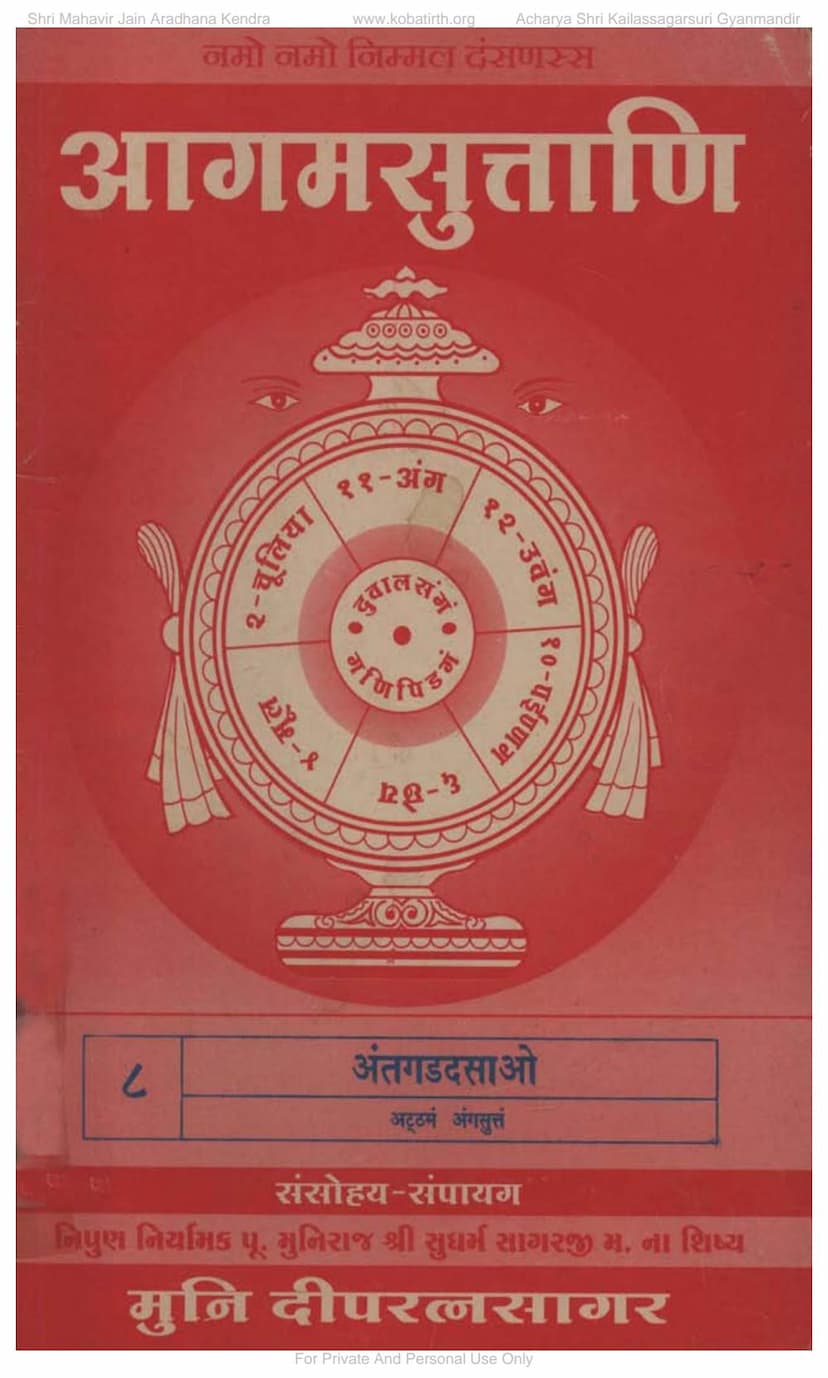Agam 08 Antgadadasao Angsutt 08 Moolam
Added to library: September 1, 2025

Summary
Here's a comprehensive summary of the provided Jain text, focusing on the content of Agam 08 Antgadadasao Angsutt 08 Moolam:
The text is the eighth Anga Sutra of the Jain Agamas, titled Antgadadasao (also transliterated as Antgadadaśāo). The primary language of the text is Ardhamagadhi Prakrit, with some sections and annotations potentially in Gujarati. The publisher is Agam Shrut Prakashan, and the edition was compiled by Muni Dippratnasagar, a disciple of Muni Sudharmasagarji.
Overall Purpose and Content:
The Antgadadasao is one of the foundational texts in the Jain canon, belonging to the Anga (limb) category of scriptures. These Angas are considered the core teachings attributed to the first Tirthankara, Rishabhanatha, and later elaborated upon by subsequent Tirthankaras, culminating in the teachings of Lord Mahavir.
The Antgadadasao primarily focuses on the lives and spiritual journeys of individuals who attained liberation (moksha). It details their past lives, the karma accumulated, the difficult ascetic practices they undertook, and how they eventually achieved omniscience and salvation. The text emphasizes the Jain principles of karma, reincarnation, renunciation, austerity (tapas), and non-violence (ahimsa) as the path to liberation.
Structure and Key Elements Highlighted in the Provided Pages:
The provided pages, while mainly consisting of preliminary information, acknowledgments, and chapter/section breakdowns, offer a glimpse into the structure and nature of the Antgadadasao:
- Title and Author: The text is clearly identified as the eighth Anga Sutra, Antgadadasao, with Muni Dippratnasagar as the compiler.
- Preliminary Pages (1-6):
- Invocation: Begin with invocations to the Jain path (Namo Namo Nirmal Desanasya) and revered spiritual preceptors (Acharya Shri Kailassagarsuri Gyanmandir, Shri Anand-Kshama-Lalit-Sushil-Sudharmasagar Gurubhyo Namah).
- Acknowledgments and Sponsorship: Extensive lists of financial donors and supporters are provided, highlighting the community's dedication to preserving and publishing these sacred texts. This indicates a significant effort in making these scriptures accessible.
- Publishing Details: Information about the publisher (Agam Shrut Prakashan), printing press, and compositors is included.
- Table of Contents/Structure Overview (Page 6): This page provides a crucial overview of the text's organization. It lists the "Vargas" (sections or chapters) and within them, the "Adhyayanas" (lessons or chapters). The Antgadadasao is divided into eight Vargas. The number of Adhyayanas in each varga is also specified, showing a structured approach to presenting the narratives.
- Notes on Sutra and Gatha Notation (Page 6): Explanations are given for the numbering systems used to refer to sutras (upa), gathas (gaha), and the commentaries (vritti). This is important for understanding the textual references.
- Content Pages (7 onwards):
- Introduction of the Text: The initial pages (from page 7) begin the actual exposition of the Antgadadasao. They often start with a narrative setup, mentioning the time, place (e.g., Champa, Dwarka), and the presence of Lord Mahavir.
- Narrative Framework: The text frequently employs a dialogue structure, often between a disciple (like Jambu) and Lord Mahavir, where the disciple asks about the path to liberation for certain individuals.
- Detailed Biographies of Liberated Souls: The core of each Adhyayana will likely focus on the life story of a specific individual who achieved liberation. This includes:
- Past Lives: Tracing their spiritual journey through multiple lifetimes.
- Karma: Explaining the specific karmic actions (good and bad) that led to their circumstances.
- Ascetic Practices: Describing the rigorous austerities, vows, and self-discipline they observed.
- Key Events and Turning Points: Highlighting significant moments in their lives that influenced their spiritual progress.
- Attainment of Moksha: Describing the final realization of omniscience and their ascent to the state of liberation.
- Examples of Narratives (as seen in the pages): The provided text starts detailing the lives of individuals like Govama, the sons of Andhakavanshi, and others, illustrating the pattern of their spiritual journeys. It mentions princes, kings, wealthy merchants, and even those in less privileged positions who achieved liberation through their conduct and austerities.
- Specific examples of individuals mentioned:
- Govama: His story is presented, including his spiritual quest and eventual liberation after a period of asceticism.
- Andhakavanshi's sons (Dhrida, Sumukha, etc.): The text begins to outline their lives and eventual attainment of liberation.
- Aniyase: The first Adhyayana of the third Vargas describes the story of Aniyase, a prince who renounced worldly life.
- Gayasukumara: A significant portion details the story of Gayasukumara, who achieved liberation despite facing intense physical suffering. The narrative highlights his unwavering determination and composure.
- Other individuals: The text continues to list and briefly describe the paths to liberation for numerous other individuals across various Vargas and Adhyayanas, such as Valadeva, Sudeśana, Dhanadeva, Harichandana, and many more queens and noble figures.
Key Jain Principles Illustrated:
- Karmic Law: The text consistently demonstrates that one's present life and future destiny are a direct result of past actions (karma).
- The Power of Austerity (Tapas): The rigorous penances and ascetic practices undertaken by the individuals are repeatedly shown as the direct means to purify karma and achieve liberation.
- Renunciation (Tyaga): Giving up worldly possessions, attachments, and sensory pleasures is a recurring theme for those seeking liberation.
- Non-violence (Ahimsa): Adherence to non-violence in thought, word, and deed is fundamental to their spiritual progress.
- The Role of Tirthankaras and Ascetics: The narratives often unfold in the presence of a Tirthankara or their disciples, who guide the protagonists on their path.
In essence, Antgadadasao serves as an inspiring collection of biographies, meticulously detailing how various souls, through diligent practice of Jain principles across multiple lifetimes, ultimately transcended the cycle of birth and death to attain the eternal state of liberation. The provided pages are part of a scholarly edition aiming to preserve and make this ancient and vital Jain scripture accessible.